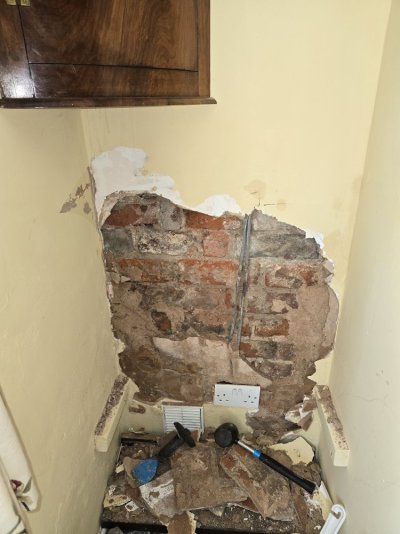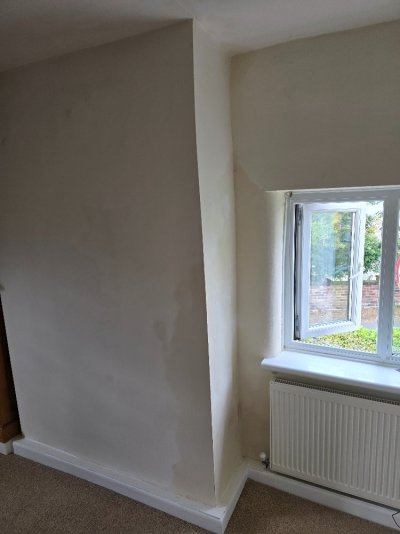Hello everyone,
Our 1850's built cheshire brick cottage(with 1980's and 2010's extensions to the rear) has two of the original exterior solid brick walls(front and gable) exposed to the elements.
Some genius has covered the exterior in concrete, and the interior in modern gypsum on top of a mix of lime render and horrible cement/bond/nastiness.
To make matters worse, the external floor level(paving flags right up to the bottom of the building, which seems to have some form of flashing as a covering, see pictures) is 2 inches higher than the interior floor level(solid slab internal floor).
Of course, this all adds up to damp, with split gypsum and staining to the original exterior facing walls only. It's not as awful as you'd expect, but it needs repair both upstairs and down.
I had a local surveyor come round, a specialist in heritage buildings, and he has a set of reccomendations which i've been following.
The first was to remove a section of the gypsum all the way back to brick, firstly to allow the wall to start drying, secondly to get a better idea of the walls makeup.
I have now done this, and it's time to decide what do. It's unlikely we will have time to render the exterior in lime any time soon, so any fix would be the only remedial work undertaken for at least a few years. I know this is already a compromise, but it's one based on costs having spent more than anticipated on the property in the first month(roof issue, followed by the boiler packing in!).
Option 1: Take the walls back to brick, render the interior in lime and a breathable paint.
- Pro's: Breathable, doesn't lose any floor space, more like the original finish.
- Cons: Expense, time to sort(we have a 2 year old running around to contend with), worry around the damp coming through the wall given the exterior still won't be breathable.
Option 2: Take the walls back to brick, build a (insulated or not) stud cavity with timbers or steel, wood fibre board and skim with lime as finish.
- Pro's: The cavity keeps the internal surface away from the brick wall, lessening chance of damp coming through the finish. Lime render skim so feels more original, neat finish, cheaper than option 1, time to sort is less than option 1.
- Cons: Even at the 'thinner' end of the scales, we'd still lose perhaps 60mm of floor space on the two walls compared to option 1. More expensive than option 3. May still not make the wall breathable enough with the cement render on the exterior wall.
Option 3(reccomendation from surveyor): Take the walls back to brick, build a (insulated or not) stud cavity with timbers or steel, vapour barrier, modern gypsum interior finish, air bricks/vents in exterior wall.
- Pro's: Cost saving as no 'specialist' skills needed. Modern finishes mean cheaper and more readily available paints. Vapour barrier/membrane means wall won't ever get damp(unless from condensation?), speed of being able to fix.
- Cons: Breathability of original masonry, potential for interstitial condensation, losing floor space.
I shall do a separate post for the ground height issues(likely a self dug gravel trench fix).
Pictures to be posted as a reply from my phone.
Your help is hugely welcomed.
Luke
Our 1850's built cheshire brick cottage(with 1980's and 2010's extensions to the rear) has two of the original exterior solid brick walls(front and gable) exposed to the elements.
Some genius has covered the exterior in concrete, and the interior in modern gypsum on top of a mix of lime render and horrible cement/bond/nastiness.
To make matters worse, the external floor level(paving flags right up to the bottom of the building, which seems to have some form of flashing as a covering, see pictures) is 2 inches higher than the interior floor level(solid slab internal floor).
Of course, this all adds up to damp, with split gypsum and staining to the original exterior facing walls only. It's not as awful as you'd expect, but it needs repair both upstairs and down.
I had a local surveyor come round, a specialist in heritage buildings, and he has a set of reccomendations which i've been following.
The first was to remove a section of the gypsum all the way back to brick, firstly to allow the wall to start drying, secondly to get a better idea of the walls makeup.
I have now done this, and it's time to decide what do. It's unlikely we will have time to render the exterior in lime any time soon, so any fix would be the only remedial work undertaken for at least a few years. I know this is already a compromise, but it's one based on costs having spent more than anticipated on the property in the first month(roof issue, followed by the boiler packing in!).
Option 1: Take the walls back to brick, render the interior in lime and a breathable paint.
- Pro's: Breathable, doesn't lose any floor space, more like the original finish.
- Cons: Expense, time to sort(we have a 2 year old running around to contend with), worry around the damp coming through the wall given the exterior still won't be breathable.
Option 2: Take the walls back to brick, build a (insulated or not) stud cavity with timbers or steel, wood fibre board and skim with lime as finish.
- Pro's: The cavity keeps the internal surface away from the brick wall, lessening chance of damp coming through the finish. Lime render skim so feels more original, neat finish, cheaper than option 1, time to sort is less than option 1.
- Cons: Even at the 'thinner' end of the scales, we'd still lose perhaps 60mm of floor space on the two walls compared to option 1. More expensive than option 3. May still not make the wall breathable enough with the cement render on the exterior wall.
Option 3(reccomendation from surveyor): Take the walls back to brick, build a (insulated or not) stud cavity with timbers or steel, vapour barrier, modern gypsum interior finish, air bricks/vents in exterior wall.
- Pro's: Cost saving as no 'specialist' skills needed. Modern finishes mean cheaper and more readily available paints. Vapour barrier/membrane means wall won't ever get damp(unless from condensation?), speed of being able to fix.
- Cons: Breathability of original masonry, potential for interstitial condensation, losing floor space.
I shall do a separate post for the ground height issues(likely a self dug gravel trench fix).
Pictures to be posted as a reply from my phone.
Your help is hugely welcomed.
Luke


